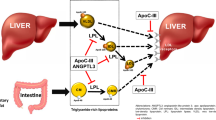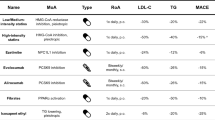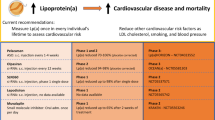Abstract
Purpose
High-density lipoprotein (HDL) undergoes structural and functional modification in patients with type 2 diabetes mellitus (T2DM). There are limited data on effect of rosuvastatin on HDL-associated proteins and the antiatherogenic effects of rosuvastatin. The present study intended to study the efficacy of rosuvastatin intervention on HDL-associated proteins and its other antiatherogenic effects in men with T2DM.
Methods
Men with T2DM on oral antidiabetic treatment, with LDL-C levels > 75 mg/dL and willing for rosuvastatin intervention (20 mg/day orally for a period of 12 weeks), were included. Fasting glucose, lipid profile were measured using standard methods. Oxidized low-density lipoprotein (oxLDL), oxidized HDL (oxHDL), paraoxonase-1 (PON-1), tumour necrosis factor-α (TNF-α) and lecithin:cholesterol acyltransferase (LCAT) in serum were measured by ELISA; serum myeloperoxidase (MPO) by spectrophotometric method and cholesterol efflux by fluorometric assay. Carotid intima-media thickness (cIMT) measurement to assess vascular health status was done using doppler.
Results
Rosuvastatin produced a significant decrease (p < 0.05) in lipids (total cholesterol, triglycerides, LDL-C); oxidative stress (oxLDL, oxHDL, MPO); inflammation (TNF-α); LCAT concentration; cIMT; significant increase in antiatherogenic HDL and cholesterol efflux (p < 0.05) and no change in apoA-I levels from baseline to 12 weeks of follow-up. A decrease in MPO activity was found to be independently associated with an increase in cholesterol efflux.
Conclusions
Post intervention there is a quantitative and qualitative improvement in HDL, which helps in its reverse cholesterol transport (RCT) and antioxidant functions. Improvement in HDL functions and suppression of inflammation by rosuvastatin lead to regression in cIMT, which is beneficial in decreasing the progression of cardiovascular disease (CVD) in men with diabetes.



Similar content being viewed by others
Change history
13 October 2020
An amendment to this paper has been published and can be accessed via a link at the top of the paper.
References
N.J. Stone, J.G. Robinson, A.H. Lichtenstein et al. American College of Cardiology/American Heart Association Task Force on Practice Guidelines. 2013 ACC/AHA guideline on the treatment of blood cholesterol to reduce atherosclerotic cardiovascular risk in adults: a report of the American College of Cardiology/American Heart Association Task Force on Practice Guidelines. J. Am. Coll. Cardiol. 63(25 Pt B), 2889–2934 (2014)
H. Soran, R. Dent, P. Durrington, Evidence-based goals in LDL-C reduction. Clin. Res. Cardiol. 106(4), 237–248 (2017)
West of Scotland Coronary Prevention Study Group, Influence of pravastatin and plasma lipids on clinical events in the West of Scotland Coronary Prevention Study (WOSCOPS). Circulation 97(15), 1440–1445 (1998)
F.M. Sacks, L.A. Moyé, B.R. Davis et al. Relationship between plasma LDL concentrations during treatment with pravastatin and recurrent coronary events in the cholesterol and recurrent events trial. Circulation 97(15), 1446–1452 (1998)
S. Lund-katz, M.C. Phillips, High density lipoprotein structure-function and role in reverse cholesterol transport. Subcell. Biochem. 51, 183–227 (2010)
S. Zhong, D.S. Sharp, J.S. Grove et al. Increased coronary heart disease in Japanese-American men with mutation in the cholesteryl ester transfer protein gene despite increased HDL levels. J. Clin. Investig. 97(12), 2917–2923 (1996)
E. Eren, N. Yilmaz, O. Aydin, High density lipoprotein and it’s dysfunction. Open Biochem. J. 6, 78–93 (2012)
E.S. Istvan, J. Deisenhofer, Structural mechanism for statin inhibition of HMG-CoA reductase. Science 292(5519), 1160–1164 (2001)
J.E. Feliciano-Alfonso, Rosuvastatin: role in cardiovascular high-risk patient. Rev. Fac. Med. 61(1), 41–51 (2013)
D. Sviridov, A. Hoang, E. Ooi et al. Indices of reverse cholesterol transport in subjects with metabolic syndrome after treatment with rosuvastatin. Atherosclerosis 197(2), 732–739 (2008)
P.R.J. Ames, A. Ortiz-Cadenas, I. Garcia De La Torre, A et al. Rosuvastatin treatment is associated with a decrease of serum oxidised low-density lipoprotein/beta2-glycoprotein I complex concentration in type 2 diabetes. Br. J. Diabetes Vasc. Dis. 10(6), 292–299 (2010)
H. Takagi, T. Umemoto; ALICE group, A meta-analysis of randomised head-to-head trials for effects of rosuvastatin versus atorvastatin on apolipoproteins profiles. Am. J. Cardiol. 113(2), 292–301 (2014)
B. Verges, E. Florentin, S. Baillot-Rudoni et al. Rosuvastatin 20 mg restores normal HDL-apo A-I kinetics in type 2 diabetes. J. Lipid Res. 50(6), 1209–1215 (2009)
R.H. Knopp, X. Zhu, Multiple beneficial effects of estrogen on lipoprotein metabolism. J. Clin. Endocrinol. Metab. 82(12), 3952–3964 (1997)
K. Griffiths, A. Pazderska, M. Ahmed et al. Type 2 diabetes in young females results in increased serum amyloid a and changes to features of high density lipoproteins in both HDL2 and HDL3. J. Diabetes Res. 2017, 1314864 (2017)
G.A. Woodard, M.M. Brooks, E. Barinas-Mitchell et al. Lipids, menopause, and early atherosclerosis in Study of Women’s Health Across the Nation Heart Women. Menopause 18(4), 376–384 (2011)
American Diabetes Association. Classification and diagnosis of diabetes Sec. 2. In Standards of medical care in diabetes—2016. Diabetes Care. 39(Suppl. 1), S13–S22 (2016)
A.M. Rao, R. Apoorva, U. Anand, C.V. Anand, G. Venu, Effect of hemodialysis on plasma myeloperoxidase activity in end stage renal disease patients. Indian J. Clin. Biochem. 27(3), 253–258 (2012)
D.J. Gordon, J.L. Probstfield, R.J. Garrison et al. High-density lipoprotein cholesterol and cardiovascular disease. Four prospective American studies. Circulation 79(1), 8–15 (1989)
A.V. Khera, M. Cuchel, M. de la Llera-Moya et al. Cholesterol efflux capacity, high-density lipoprotein function, and atherosclerosis. N. Engl. J. Med. 364(2), 127–135 (2011)
D.W. Bilheimer, S.M. Grundy, M.S. Brown, J.L. Goldstein, Mevinolin and colestipol stimulate receptor-mediated clearance of low density lipoprotein from plasma in familial hypercholesterolemia heterozygotes. Proc. Natl. Acad. Sci. USA 80(13), 4124–4128 (1983)
K.Y. Jung, K.M. Kim, S.K. Han et al. Effect of rosuvastatin on cholesterol efflux capacity and endothelial function in type 2 diabetes mellitus and dyslipidemia. Circ. J. 82(5), 1387–1395 (2018)
C.P. Shah, D.K. Kumbla, A. Moorthy et al. A post-marketing study evaluating the lipid-altering efficacy and safety of approved dose ranges of rosuvastatin in Indian hyperlipidemia patients in routine clinical practice (ROSUVEES). J. Indian Coll. Cardiol. 5(4), 282–290 (2015)
S.J. Nicholls, G. Brandrup-wognsen, M. Palmer et al. Meta-analysis of comparative efficacy of increasing dose of atorvastatin versus rosuvastatin versus simvastatin on lowering levels of atherogenic lipids (from VOYAGER). Am. J. Cardiol. 105(1), 69–76 (2010)
J. Yang, L.J. Li, K. Wang et al. Race differences: modeling the pharmacodynamics of rosuvastatin in Western and Asian hypercholesterolemia patients. Acta Pharmacol. Sin. 32(1), 116–125 (2011)
M. Triolo, W. Annema, J.F. Deboer et al. Simvastatin and bezafibrate increase cholesterol efflux in men with type 2 diabetes. Eur. J. Clin. Investig. 44(3), 240–248 (2014)
M. Miyamoto-Sasaki, T. Yasuda, T. Monguchi et al. Pitavastatin increases HDL particles functionally preserved with cholesterol efflux capacity and antioxidative actions in dyslipidemic patients. J. Atheroscler. Thromb. 20(9), 708–716 (2013)
H. Soran, Y. Liu, S. Adam et al. A comparison of the effects of low- and high-dose atorvastatin on lipoprotein metabolism and inflammatory cytokines in type 2 diabetes: results from the Protection Against Nephropathy in Diabetes with Atorvastatin (PANDA) randomized trial. J. Clin. Lipidol. 12(1), 44–55 (2018)
N.D. Vaziri, K. Liang, Effects of HMG-CoA reductase inhibition on hepatic expression of key cholesterol-regulatory enzymes and receptors in nephrotic syndrome. Am. J. Nephrol. 24(6), 606–613 (2004)
T. Shimizu, S. Miura, H. Tanigawa et al. Rosuvastatin activates ATP-binding cassette transporter A1-dependent efflux ex vivo and promotes reverse cholesterol transport in macrophage cells in mice fed a high-fat diet. Arterioscler. Thromb. Vasc. Biol. 34(10), 2246–2253 (2014)
D. Bhatnagar, P.N. Durrington, S. Kumar, M.I. Mackness, J. Dean, A.J. Boulton, Effect of treatment with a hydroxy methyl glutaryl coenzyme A reductase inhibitor on fasting and postprandial plasma lipoproteins and cholesteryl ester transfer activity in patients with NIDDM. Diabetes 44(4), 460–465 (1995)
L. Masana, A. Cabré, M. Heras et al. Remarkable quantitative and qualitative differences in HDL after niacin or fenofibrate therapy in type 2 diabetic patients. Atherosclerosis 238(2), 213–219 (2015)
J.M. Hoeg, S. Santamarina-Fojo, A.M. Berard et al. Overexpression of lecithin:cholesterol acyltransferase in transgenic rabbits prevents diet-induced atherosclerosis. Proc. Natl. Acad. Sci. USA 93(21), 11448–11453 (1996)
R.P. Dullaart, F. Perton, W.J. Sluiter, R. de Vries, A. van Tol, Plasma lecithin: cholesterol acyltransferase activity is elevated in metabolic syndrome and is an independent marker of increased carotid artery intima media thickness. J. Clin. Endocrinol. Metab. 93(12), 4860–4866 (2008)
A.B. Kosek, D. Durbin, A. Jonas, Binding affinity and reactivity of lecithin cholesterol acyltransferase with native lipoproteins. Biochem. Biophys. Res. Commun. 258(3), 548–551 (1999)
A. Hafiane, J. Genest, High density lipoproteins: measurement techniques and potential biomarkers of cardiovascular risk. BBA Clin. 3, 175–188 (2015)
A.A. Abdin, M.A. Hassanien, E.A. Ibrahim, S.A. El-Noeman, Modulating effect of atorvastatin on paraoxonase 1 activity in type 2 diabetic Egyptian patients with or without nephropathy. J. Diabetes Complicat. 24(5), 325–333 (2010)
J. Christison, A. Karjalainen, J. Brauman, F. Bygrave, R. Stocker, Rapid reduction and removal of HDL-but not LDL-associated cholesteryl ester hydroperoxides by rat liver perfused in situ. Biochem. J. 314(Pt 3), 739–742 (1996)
K. Torimoto, Y. Okada, H. Mori et al. Efficacy of combination of ezetimibe 10 mg and rosuvastatin 2.5 mg versus rosuvastatin 5 mg monotherapy for hypercholesterolemia in patients with type 2 diabetes. Lipids Health Dis. 12, 137 (2013)
E. Mandosi, M. Fallarino, A. Gatti et al. Atorvastatin downregulates monocyte CD36 expression, nuclear NFkappaB and TNF alpha levels in type 2 diabetes. J. Atheroscler. Thromb. 17(6), 539–545 (2010)
L. Wei, M. Yamamoto, M. Harada, M. Otsuki, Treatment with atorvastatin attenuates progression of insulin resistance and pancreatic fibrosis in the Otsuka Long-Evans Tokushima fatty rats. Metab. Clin. Exp. 65(2), 41–53 (2016)
K. Yanagi, T. Monden, S. Ikeda et al. A crossover study of rosuvastatin and pitavastatin in patients with type 2 diabetes. Adv. Ther. 28, 160–171 (2011)
G. Ma, S. Bi, Effect of rosuvastatin on vascular endothelial functions and inflammatory factors of patients with type 2 diabetes mellitus and coronary heart disease. Exp. Ther. Med. 17(1), 332–336 (2019)
K. Wu, S. Tian, H. Zhou, Y. Wu, Statins protect human endothelial cells from TNF-induced inflammation via ERK5 activation. Biochem. Pharmacol. 85(12), 1753–1760 (2013)
A. Link, T. Ayadhi, M. Böhm, G. Nickenig, Rapid immunomodulation by rosuvastatin in patients with acute coronary syndrome. Eur. Heart J. 27(24), 2945–2955 (2006)
A. Mohan, S. Sada, B.S. Kumar et al. Subclinical atherosclerosis in patients with rheumatoid arthritis by utilizing carotid intima-media thickness as a surrogate marker. Indian J. Med. Res. 140(3), 379–386 (2014)
Society of Atherosclerosis Imaging and Prevention developed in collaboration with the International Atherosclerosis Society, Appropriate use criteria for carotid intima media thickness testing. Atherosclerosis 214(1), 43–46 (2011)
P. Greenland, J.S. Alpert, G.A. Beller et al. 2010 ACCF/AHA guideline for assessment of cardiovascular risk in asymptomatic adults: a report of the American College of Cardiology Foundation/American Heart Association Task Force on Practice Guidelines. Circulation 122(25), e584–e636 (2010)
A.V. Khera, O.V. Demler, S.J. Adelman et al. Cholesterol efflux capacity, high-density lipoprotein particle number, and incident cardiovascular events: an analysis from the JUPITER trial (justification for the use of statins in prevention: an intervention trial evaluating rosuvastatin). Circulation 135(25), 2494–2504 (2017)
F.R. Jornayvaz, M.C. Brulhart-meynet, R.W. James, Myeloperoxidase and paraoxonase-1 in type 2 diabetic patients. Nutr. Metab. Cardiovasc. Dis. 19(9), 613–619 (2009)
P.G. Scheffer, R.K. Schindhelm, V.M. vanVerschuer et al. No effect of atorvastatin and simvastatin on oxidative stress in patients at high risk for cardiovascular disease. Neth. J. Med. 71(7), 359–365 (2013)
J.R. Crouse, J.S. Raichlen, W.A. Riley, METEOR Study Group et al. Effect of rosuvastatin on progression of carotid intima-media thickness in low-risk individuals with subclinical atherosclerosis: the METEOR Trial. JAMA 297(12), 1344–1353 (2007)
Acknowledgements
We would also like to thank Dr. Vijayalakshmi Venkatesan, Scientist G & HOD, Stem Cell Biology, National Institute of Nutrition, Hyderabad, for making the facilities available for carrying out cholesterol efflux analysis. We are also thankful to Mr. KNS Prasad, Senior Research Fellow, Stem Cell Biology, NIN, Hyderabad, for technical support in cholesterol efflux analysis.
Funding
Sri Balaji Arogya Vara Prasadini Scheme [(SBAVP-RG/Ph.D/21) and (Faculty/ERPW/51-2017-18)] of Sri Venkateswara Institute of Medical Sciences, Tirupati, AP, India, provided financial support.
Author information
Authors and Affiliations
Corresponding author
Ethics declarations
Conflict of interest
The authors declare that they have no conflict of interest.
Ethical approval
The study was approved by the Institutional Ethics Committee and registered with the Clinical Trials Registry of India (CTRI/2017/09/009695).
Additional information
Publisher’s note Springer Nature remains neutral with regard to jurisdictional claims in published maps and institutional affiliations.
Rights and permissions
About this article
Cite this article
Naresh, S., Bitla, A.R., Rao, P.V.L.N.S. et al. Efficacy of oral rosuvastatin intervention on HDL and its associated proteins in men with type 2 diabetes mellitus. Endocrine 71, 76–86 (2021). https://doi.org/10.1007/s12020-020-02472-5
Received:
Accepted:
Published:
Issue Date:
DOI: https://doi.org/10.1007/s12020-020-02472-5




